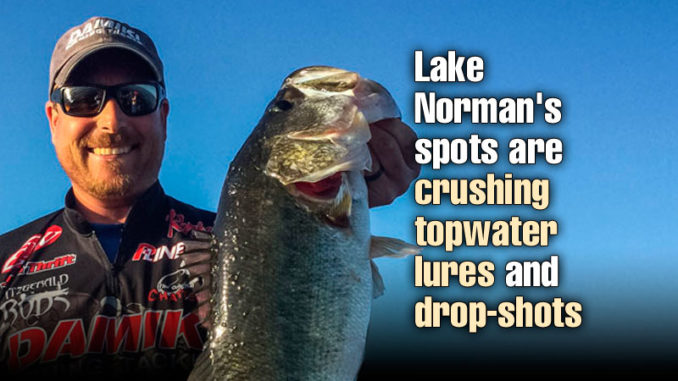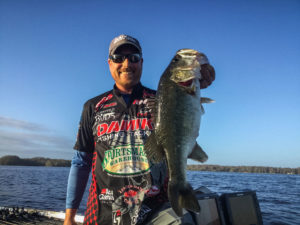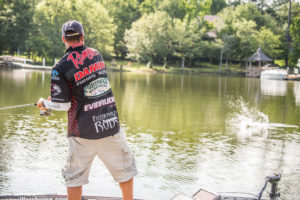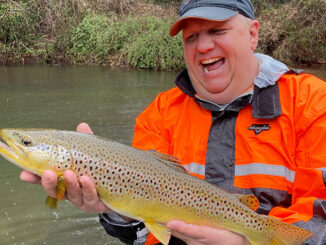
One bass pro has a two-pronged approach to catching schooling spotted bass during the summer’s hottest days.
With the sweltering heat of July comes a waterborne epidemic that sweeps through fishermen on Lake Norman: Lake Norman spotted fever. Spotted bass, that is.
Technically, the stricken may still go about their normal daily activities. But with action this hot, it isn’t advised. As large schools of spots huddle up on main-lake points, the best remedy is to follow the counsel of a professional, like pro bass angler Bryan Thrift of Shelby N.C. He suggest anglers take two baits and go fishing in the morning.
According to Thrift, the morning is a great time to start. But Lake Norman’s nomadic spots stay aggressive and hungry throughout the day, ready to pounce on a topwater walking lure or drop-shot rig.
“You can throw topwater all day at Norman,” said Thrift, one of the nation’s top-ranked bass pros. “Those spots get out there and suspend in 20 to 30 feet of water. But they’ll only be 10 or 15 feet deep. The water is so clear, you can call them to the top all-day long. They can school and come up anytime, anywhere. I use the drop-shot to catch the fish under the boat that I see on my graph.”
Best of all, this isn’t the typical, slow grind of summer most anglers are accustomed to when targeting largemouth bass. Spots are a bit of a different breed. They are less affected by hot water and more inclined to school than largemouths. Spots will inhabit Norman’s open-water terrain in the summer. Anglers are likely to catch them alongside the stripers and hybrid bass that they mimic.
Spots are different than largemouths in several ways

While sometimes confused with largemouths, spots exhibit a number of distinguishing features. The first giveaway is a noticeably smaller mouth, which does not extend beyond the eye when closed. Often longer and more slender than the largemouth, the spotted bass sports numerous distinctive spots on the lower side of the body. The best method for making a positive ID is to feel for the sandpaper-like tooth patch that largemouths don’t have.
Although a shade on the leaner side of their largemouth cousins, spots make up for it with tenacity and numbers. “The average size of a spot on Lake Norman is 1 ½ to 2 ½ or 3 pounds,” Thrift said. “Every once in awhile, you’ll catch a 4-pounder. Most are in that good keeper size range, 14 to 18 inches. But you can set up and work a point and catch 25 to 30 fish. It’s a lot of fun.”
Thrift’s game plan when approaching promising main-lake points likely to be occupied by spots is to wake up the neighborhood.
“Most of the points that have spots will have a lot of bait around them,” he said. “And that little bit of water movement when you set the boat down will make that bait move around. That will get them fired up for the first several minutes.
Keep an eye on your electronics to find these fish
“I’ll pull up and throw topwater instantly,” he said. “I like to use a Damiki Rambler 120 in the real shad color. It’s a walking style bait. Throw it out and walk it as fast as you can back to the boat. But I always have the drop-shot tied on. When I see one on the graph, I’ll have it ready.”
After the burst of topside activity, Thrift gets down to serious business, keeping one eye on his topwater and the other on his electronics as he dissects the point.
 “I basically troll around,” he said. “I put my trolling motor on 30 to 40 percent and move around until I see them.”
“I basically troll around,” he said. “I put my trolling motor on 30 to 40 percent and move around until I see them.”
With a target in his crosshairs, Thrift hovers above his quarry and sends his offering straight to the bottom.
“Most of the time they’ll follow it down, and I would say 70 percent of them will bite it on the drop. I use a Damaki 4-inch soft-plastic Stinger and hook it on a 1/0 drop-shot hook using 8-pound fluorocarbon. Depending on depth, I’ll use a 3/16- or a ¼-ounce weight about a foot below the hook. I only use two colors: watermelon candy and baby bass.”
At more than 32,000 acres, Lake Norman is a handful in terms of picking apart profitable locations. But Thrift keys on the lower third of the lake because it’s deeper. Here, he hones in on main lake points in the 20 to 40 foot ranges.
“They’ll be on the points that run out the farthest,” he said, “the most prominent and obvious points (and) particularly those around Davidson and Ramsey creeks.”
DESTINATION INFORMATION
HOW TO GET THERE — Less than 20 miles north of Charlotte, N.C., Lake Norman is sandwiched between east-west I-40 at its extreme northern end and 1-77 running north-south along its eastern banks. Plenty of boat ramps line its shores, including McCrary Creek Access and Pinnacle Access on NC 150, which crosses at mid-lake, Blythe Landing off NC 73 near the dam, and Beatty’s Ford and Little Creek on the western side of the lake.
WHEN TO GO — Spots behave in a similar fashion to largemouth in the spring, spawning around boat docks and keeping to the creeks. But as the water temperature climbs, most spots will leave the creeks and mingle with the hybrid bass and huge bait schools found in the main lake. By July and through early fall, spots will be found in the heaviest concentrations on the lower third of the lake. However, hardy spotted bass are also a hot winter target at Norman.
BEST TECHNIQUES — Topwater walk-the-dog baits will call spotted bass out of deep water around points; bass pro Brian Thrift fishes a Damiki 120 in real shad color on a medium-heavy bait casting outfit spooled with 15-pound fluorocarbon. A drop-shot rig and soft-plastic Damiki Stinger in watermelon candy or baby bass is another alternative, fished on a medium-light spinning outfit.
FISHING INFO/GUIDES — Capt. Craig Price, Fish On! Guide Service, 704-996-0946, www.fishonlakenorman.com; Lake Norman Bait and Tackle, 704-658-1113, www.lakenormantackle.com; See also Guides and Charters in Classifieds.
ACCOMMODATIONS — Clarion Inn, Cornelius, 704-896-0660; Holiday Inn Express and Suites, Huntersville, 704-892-9487; Sleep Inn and Suites, Huntersville, 704-766-2500.
MAPS — FHS Maps, 800-ALL-MAPS, www.fishinghotspots.com.
Click here to read about catching spots on the Cape Fear River.




